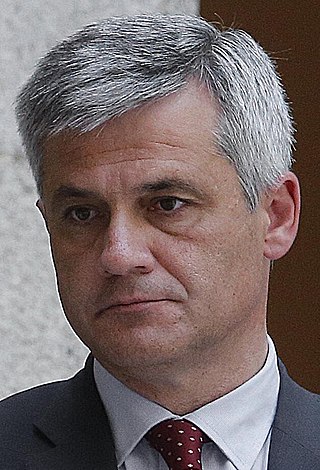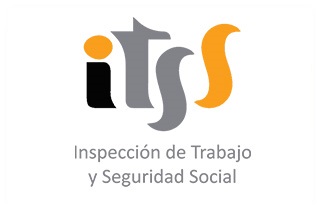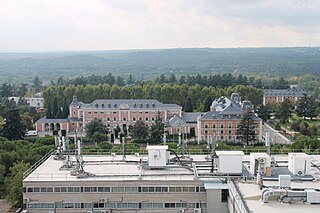
The Ministry of Transport and Sustainable Mobility (MITMA), traditionally known as the Ministry of Development (MIFOM), is the department of the Government of Spain responsible for preparing and implementing the government policy on land, air and maritime transport infrastructure and the control, planning and regulation of the transport services on this areas. It is also responsible for guaranteeing access to housing; urban, soil and architecture policies; planning and controlling the postal and telegraph services, directing the services related to astronomy, geodesy, geophysics and mapping, and planning and programing the government investments on infrastructure and services related to this scope. The Ministry's headquarters are in the New Ministries government complex.

The Ministry of the Interior (MIR) is a department of the Government of Spain responsible for public security, the protection of the constitutional rights, the command of the law enforcement agencies, national security, immigration affairs, prisons, civil defense and road traffic safety. Through the Undersecretariat of the Interior and its superior body, the Directorate-General for Internal Policy, the Ministry is responsible for all actions related to ensuring political pluralism and the proper functioning of electoral processes.

The Emergency Military Unit is a branch of the Spanish Armed Forces responsible for providing disaster relief throughout Spain mainly, and abroad if required. It is the newest branch of the Spanish Armed Forces.

The Ministry of Defence (MINISDEF) is the department of the Government of Spain responsible for planning, developing and carrying out the general guidelines of the Government about the defence policy and the managing of the military administration. It is the administrative and executive body of the Spanish Armed Forces.

The Ministry of the Presidency (MPR) was the department of the Government of Spain that, from 1974 to 2023, assured the link between the different Ministries and the Prime Minister and it was responsible for the relations between the Government and the Parliament. This department also supported The Crown in the exercise of its functions.

The Chief of the Defence Staff is the highest-ranking military officer in the Spanish Armed Forces and is the principal military advisor to the Prime Minister, the Minister of Defence, the National Defence Council and the National Security Council. It is the fourth military authority of the country after the Monarch, the Prime Minister and the Minister of Defence because the Secretary of State for Defence and the Under-Secretary of Defence do not have military authority.

The Intelligence Center for Counter-Terrorism and Organized Crime is the Spanish domestic intelligence agency responsible for the prevention of terrorism, organized crime and other violent radical organizations by managing and analyzing all internal information of the country. It was formed in October 2014 by merging of the National Anti-Terrorism Coordination Center and Intelligence Center against Organized Crime.

The Secretary of State for Security (SES) of Spain is the second-highest-ranking official in the Ministry of the Interior.

The General Commissariat of Information is an intelligence service within the National Police Corps of Spain responsible for the collection, analysis and distribution of information relevant to domestic security, as well as its exploitation or operational use, especially in matters of counterterrorism, both nationally and internationally. It may be regarded as the Spanish equivalent of the United Kingdom's Special Branch.

The Secretary of State for Defence (SEDEF) is the second-highest-ranking official in the Ministry of Defence of Spain. The SEDEF is a civilian which is appointed by the King with the advice of the Defence Minister. In spite of being the second authority of the Ministry, it is behind the Chief of the Defence Staff as far as military control is concerned.
The Directorate-General of the Police (DGP) is a component of the Spanish Department of the Interior responsible for exercising the direct command of the National Police Corps, the main civil law enforcement agency of Spain. The DGP, integrated in the Secretariat of State for Security, is in charge of organize, direct, coordinate and execute the missions entrusted to the National Police by the provisions in force, in accordance with the guidelines and orders issued by the Minister of the Interior.

The Secretary of State for Infrastructure, Transport and Housing (SEITV) is a high-ranking official of the Ministry of Development of the Government of Spain. The SEITV is appointed by the King of Spain at the proposal of the Minister of Development.

The Secretary of State for Social Security and Pensions (SESSP) is a senior minister of the Government of Spain, under the authority of the Social Security Minister, responsible for the direction and guardianship of the managing agencies and common services of the Social Security; the impulse, direction and economic and financial analysis of the Social Security System; as well as the planning and supervision of the management of the collaborating entities of the Social Security complementary to the Social Security action.

The Ministry of Social Affairs (MAS), since 2023 known as Ministry of Social Rights, Consumer Affairs and 2030 Agenda, is a department of the Government of Spain responsible for the government policies on social services, family, minors protection, disability and prevention of youth crime, adoptions and foster care and the promotion of cultural communication and youth association. Likewise, the department is responsible for the government policies on animal welfare and UN Sustainable Development Goals.

The Labour and Social Security Inspectorate (ITSS) is a Spanish autonomous agency in charge of the control of the compliance with labour and social security legislation. It also offers technical advice and, where appropriate, conciliation, mediation and arbitration in these matters. The ITSS is, therefore, the apex of the Labour and Social Security Inspection System.

In Spain, apart from the Central Administration, the central government has a Peripheral Administration. This administration is composed of all those decentralized government services, and they are coordinated by the Government Delegations, which are headquartered in the Spanish regions' capitals. Likewise, this delegations exercise its powers through sub-delegations, headquartered in the provinces and insular directorates, headquartered in some islands. In total, there are 19 government delegations, 44 sub-delegations and 7 insular directorates.
The Directorate-General of the Civil Guard (DGGC) is a component of the Spanish Department of the Interior responsible for exercising the direct command of the Civil Guard law enforcement agency. The DGGC, integrated in the Secretariat of State for Security, is in charge of organize, direct, coordinate and execute the missions entrusted to the Civil Guard by the provisions in force, in accordance with the guidelines and orders issued by the Ministers of the Interior and of Defense, within the scope of their respective powers.

The Ministry of Inclusion, Social Security and Migration is a department of the government of Spain responsible for planning and carrying out the government policy on Social Security, foreigners, immigration and emigration.

The Coordination Centre for Health Alerts and Emergencies is a body of the Spanish Ministry of Health responsible for coordinating the management of information and supporting all health authorities in cases of national or international health alert or emergency situations that pose a threat to the health of the population. This centre is also the unit responsible in Spain for preparing and developing response plans to deal with public health threats.

The Office of the Prime Minister, officially Presidency of the Government is the Spanish government structure that groups all the departments and officials that are at the service of the prime minister to fulfil its constitutional duties. It is staffed by a mix of career civil servants and advisers. The highest-ranking official within the Office is the Chief of Staff, which is a political appointment on which the rest of the Office officials depend.
































